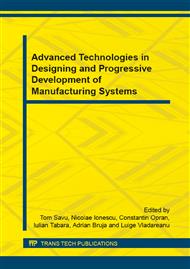p.433
p.439
p.445
p.451
p.457
p.463
p.469
p.475
p.483
Researches on Milling Machining of Planar Thin Wall Parts
Abstract:
In the paper are presented some experimental and by simulation results obtained in the machining by milling of plane surfaces of thin walls parts. Two case studies are considered: when the thin wall is vertical and then the thin wall is horizontal positioned. Some values of the cutting force components are established using a modern dynamometer and a data acquisition system. The elastic deformation values of the machined part are also determined by experimental tests and simulated in a FEM analysis. Depending on the data that geometrically define the part and the cutting tools, their materials and the cutting parameters, are set values of the cutting forces and powers. There are presented the results of values comparison obtained by measuring during the processes with those established by applying FEM. Both case studies results lead to some remarks and useful recommendations for determining the machining parameters and the needed conditions for the technological system in the processing of parts with thin walls and minimum deformations.
Info:
Periodical:
Pages:
457-462
Citation:
Online since:
May 2015
Authors:
Price:
Сopyright:
© 2015 Trans Tech Publications Ltd. All Rights Reserved
Share:
Citation:


